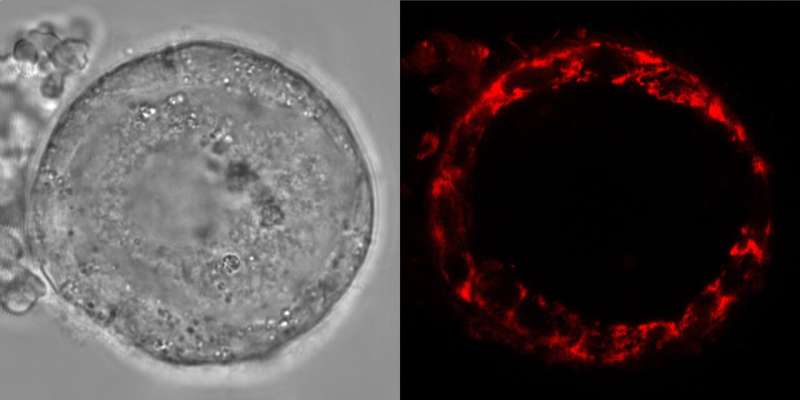Human eggs remain healthy for decades by putting 'batteries on standby mode'

Immature human egg cells skip a fundamental metabolic reaction thought to be essential for generating energy, according to the findings of a study by researchers at the Center for Genomic Regulation (CRG) published today in the journal Nature.
By altering their metabolic activity, the cells avoid creating reactive oxygen species, harmful molecules that can accumulate, damage DNA and cause cell death. The findings explain how human egg cells remain dormant in ovaries for up to 50 years without losing their reproductive capacity.
"Humans are born with all the supply of egg cells they have in life. As humans are also the longest-lived terrestrial mammal, egg cells have to maintain pristine conditions while avoiding decades of wear-and-tear. We show this problem is solved by skipping a fundamental metabolic reaction that is also the main source of damage for the cell. As a long-term maintenance strategy, its like putting batteries on standby mode. This represents a brand new paradigm never before seen in animal cells," says Dr. Aida Rodriguez, postdoctoral researcher at the CRG and first author of the study.
Human eggs are first formed in the ovaries during fetal development, undergoing different stages of maturation. During the early stages of this process, immature egg cells known as oocytes are put into cellular arrest, remaining dormant for up to 50 years in the ovaries. Like all other eukaryotic cells, oocytes have mitochondria—the batteries of the cell—which they use to generate energy for their needs during this period of dormancy.
Using a combination of live imaging, proteomic and biochemistry techniques, the authors of the study found that mitochondria in both human and Xenopus oocytes use alternative metabolic pathways to generate energy never before seen in other animal cell types.
A complex protein and enzyme known as complex I is the usual "gatekeeper" that initiates the reactions required to generate energy in mitochondria. This protein is fundamental, working in the cells that constitute living organisms ranging from yeast to blue whales. However, the researchers found that complex I is virtually absent in oocytes. The only other type of cell known to survive with depleted complex I levels are all the cells that make up the parasitic plant mistletoe.
According to the authors of the study, the research explains why some women with mitochondrial conditions linked to complex I, such as Leber's Hereditary Optic Neuropathy, do not experience reduced fertility compared to women with conditions affecting other mitochondrial respiratory complexes.
The findings could also lead to new strategies that help preserve the ovarian reserves of patients undergoing cancer treatment. "Complex I inhibitors have previously been proposed as a cancer treatment. If these inhibitors show promise in future studies, they could potentially target cancerous cells while sparing oocytes," explains Dr. Elvan Böke, senior author of the study and Group Leader in the Cell & Developmental Biology program at the CRG.
Oocytes are vastly different to other types of cells because they have to balance longevity with function. The researchers plan to continue this line of research and uncover the energy source oocytes use during their long dormancy in the absence of complex I, with one of the aims being to understand the effect of nutrition on female fertility.
"One in four cases of female infertility are unexplained—pointing to a huge gap of knowledge in our understanding of female reproduction. Our ambition is to discover the strategies (such as the lack of complex I) oocytes employ to stay healthy for many years in order to find out why these strategies eventually fail with advanced age," concludes Dr. Böke.
More information: Elvan Böke, Oocytes maintain ROS-free mitochondrial metabolism by suppressing complex I, Nature (2022). DOI: 10.1038/s41586-022-04979-5. www.nature.com/articles/s41586-022-04979-5
Journal information: Nature
Provided by Center for Genomic Regulation




















